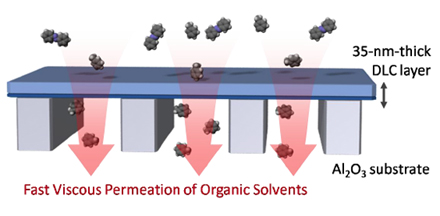Development of High Performance Filtration Membranes Enabling Oil Purification
World's First Demonstration of Ultrafast Viscous Permeation in Nanoporous Membranes
2012.01.27
(2012.02.01 Update)
National Institute for Materials Science
Japan Science and Technology Agency
NIMS researchers in the Polymer Materials Unit, Advanced Key Technologies Division developed extremely thin porous carbon membranes with resistance to organic solvents and succeeded in increasing the impurity removal speed by approximately 3 orders in comparison with conventional filtration membranes.
概要
- A team of researchers in the Separation Functional Materials Group of the Polymer Materials Unit (Unit Director: Izumi Ichinose), Advanced Key Technologies Division, National Institute for Materials Science (President: Sukekatsu Ushioda), in joint research with the NIMS Transmission Electron Microscopy Station, Research Network and Facility Services Division, succeeded in developing extremely thin porous carbon membranes with pores having a diameter of approximately 1 nm.
- Filtration membranes with organic solvent resistance will open a promising technology for a wide range of applications, including production of ultra-low sulfur diesel oil, waste water treatment processes for oil sand development, and recycling of catalysts in the chemical industry, among others. However, the conventional filtration membranes were easily deteriorated by acids, alkalines, heat, etc., and it was difficult to pass solvents other than water through the membranes with fine pores of about 1 nm order.
- In the present research, the NIMS team succeeded in fabricating filtration membranes which have diamond-like mechanical strength but is also extremely thin at approximately 35 nm in thickness. Because a very large number of flow channels with diameters of approximately 1 nm are formed in the interior of the carbon nanosheet, ultrafast permeation of organic solvents is possible. The permeation rate of hexane, which is one constituent of oil, exceeded 230 L/h・m2・bar, and the rejection of azobenzene (molecular weight: 182.2), which was used as a model impurity, was more than 90%. Processing speed was approximately 3 orders faster than that of commercial filters with similar performance.
- When an organic solvent passes through a channel, its velocity increases in inverse proportion to the viscosity of the solvent. In other words, organic solvents flow through the channel faster as their viscosity decreases. In the present research, it was found that this phenomenon (viscous permeation) can be observed even in ultra-small flow paths with a diameter of 1 nm. The discovery that a molecular-scale flow is dependent on the macroscopic physical property of viscosity is particularly surprising.
- This research result was obtained in the Research Project “Macroscopic Properties of Liquids in Interfacial Nanopores (Research Director: Izumi Ichinose)” in the JST-CREST Research Area “Development of the Foundation for Nano-Interface Technology (Research Supervisor: Seiji Shinkai)” and was published in the journal Science (AAAS, United States) on January 27, 2012.
(S. Karan, S. Samitsu, X. Peng, K. Kurashima, I. Ichinose “Ultrafast Viscous Permeation of Organic Solvents Through Diamond-Like Carbon Nanosheets” DOI: 10.1126/science.1212101)

Figure 1 Schematic diagram of the ultra-high performance filtration membrane. An organic solvent (toluene) permeates at high speed through the carbon membrane (DLC Layer), which has a thickness of only 35 nm, but a model impurity (azobenzene) is stopped by the membrane. The carbon membrane consists of a nanoporous diamond-like carbon (DLC) material.
